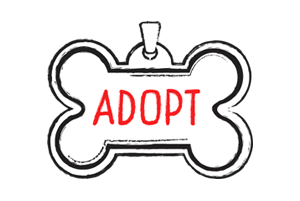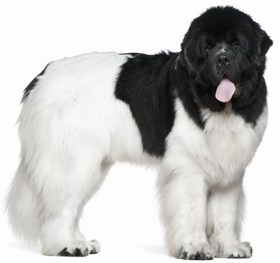
Paws ‘N’ Pups Quickview
Size
| Energy Level
| Trainability
| Paws ‘N’ Pups Rank
|
Characteristics
| Physical Characteristics: Height: 26-35” Weight: 140-260 lbs. Energy Level: Low | Colors: The American Kennel Club recognizes the Saint Bernard in the following colors:
|
Health & Longevity
Average Life Span: 8-10 years
One of the most popular large dog breeds, the Saint Bernard is a giant pup with generally positive health. These pups are prone to the usual ailments that can have an effect on any canine, such as heartworms and cancer, but their genetic health conditions consist of the illnesses of a big pup. They may have problems with their bones and muscles as they grow, because their bodies grow at such a quick rate. It takes a lot of energy and tissue to accommodate that kind of growth.
Two health complications that your Saint Bernard might face include:
Elbow Dysplasia
Common at birth in large breeds, this condition occurs when the joint and socket are malformed, resulting in random dislocation. If left untreated, it could result in arthritis, nerve damage, cartilage deterioration, and a permanent limp. Surgery is required to permanently correct this condition.
Heart Disease
While all dogs can develop heart disease, Saint Bernards are especially prone to heart valve blockages due to their size and limited genetic generations. This condition, while incurable, can be helped with surgery to clear blockages. Unfortunately, vet-prescribed medication is a lifelong must to manage the disease.
Other health problems that your Saint Bernard may encounter are hip dysplasia, skin allergies, and cherry eyes. The average lifespan of a Saint Bernard is between 8 to 10 years. You can ensure your Saint Bernard lives the entirety of that lifespan with routine vet visits, a nutritious diet, and tons of regular exercise.
Temperament & Train-ability
Saint Bernards are normally sweet, affectionate, gentle giants who crave human attention and regular companionship. These pups, albeit large, require only moderate exercise, so a few walks would suffice throughout the morning and afternoon. Or, take her to the dog park to commune and romp with other large dogs. She might be the biggest there, but she is sure to be the gentlest and most considerate.
These big pups are good with older children, but they may accidentally knock down younger children with their overall size. They are also great with other dogs, especially ones they’ve grown up with. Rare barkers, the Saint Bernard will instead alert you to suspicious activities with a nudge while you sleep. Her big head is strong and powerful, so you will definitely feel the force behind her nudge if she senses something threatening.
It is in a Saint Bernard’s nature to please her owners, so training should be a cinch. She loves attention and praise; so, positive encouragement is the best method for training your Saint Bernard. Use the occasional meaty morsel to reward her for good behavior, but keep most of the positive reinforcement to head rubs and belly pats.
Grooming
Gigantic and shaggy, Saint Bernards can be difficult to groom alone. Many pet owners opt to take their Saint Bernard to a professional groomer for the usual bath, brush, and trim. However, if you prefer to brave the grooming regimen yourself, here’s what you should know.
Saint Bernards have an abundance of thick, sometimes unruly, and lengthy hair, so she needs to be brushed once a day. Sometimes, she will need to be brushed twice if she happens to spend tons of time outdoors. Use a huge, firm-bristled brush to detangle any knots and break up any kinks. Smooth out her hair as you go, making it easier to manage between brush strokes.
You will definitely need to take your Saint Bernard to a professional groomer for a bath every 2-3 months, or whenever she gets dirty and smelly – whichever comes first. You could also opt for a dry shampoo to keep her fur soft, pleasant, and manageable. On nice summer days, take her outdoors to give her a good scrub-down with a garden hose and gentle dog shampoo.
In terms of basic care, the following are important aspects that of hygiene that need to take place regularly. You should clip toenails every 2-3 weeks, especially if you can hear her nails clicking when walking. Brushing teeth every other day promotes healthy gums and teeth. It is also important to check and clean ears once a week to prevent infection.
Diet
Saint Bernard puppies are born with giant, hearty appetites to match their large stature. Because of their varying sizes and needs, it is best to ask your vet what is the recommended amount of food your Saint Bernard needs to meet her nutritional goals. Most Saint Bernards eat twice a day, but the amount of food varies between 4 to 8 cups of dry, high-quality kibble divided into two meals. These pups need plenty of nutrient-rich dog food to maintain a good overall health.
When it comes to high-quality kibble, ingredients make a huge difference. Again, you should ask your vet what they recommend. But bear in mind that nutritious dog food begins with whole grains, lean meats, and vegetables. These should be the first three ingredients on any dog food label. Sure, it might cost a bit more, but the nutrition and overall health of your Saint Bernard are far more important.
Looking for a Saint Bernard?
 Find A Saint Bernard Breeder |  Saint Bernard Puppies For Sale |  Adopt A Saint Bernard |
Cost
Saint Bernards are some of the most challenging pups to find in a local animal shelter or rescue group, but you should check anyway. You might get lucky, in which case the adoption fee could be upwards of $250. Most adoption costs depend on county and state regulations, so call around before you go. Adoptions usually mean an older, more mature Saint Bernard. You should consider it a good thing since you are offering a happy forever home to an abandoned, sweet pup.
If you go to a breeder, expect to pay around $1,000 for a Saint Bernard puppy. Ask for purebred documentation and health records when you invest in a new companion canine. Reputable breeders will be able to provide what you ask without problem or incident.
Paws ‘N’ Pups Ranking
Paws ‘N’ Pups ranks every breed out of 4 with 1 being easiest to integrate into your life and 4 being the toughest – The lower the ranking the better.
Ranking takes into account a few basic factors including cost, skill level needed, high vs low maintenance and how critical regular training is to success. Because of their overall size and space requirements, the Saint Bernard is a solid 2.5 on the Paws ‘N’ Pups scale. These pups are sweet and gentle, but their large stature might make it a challenge to live with them if they are clumsy, awkward, or unaware of how big they are.
Saint Bernards also drool a ton, need a high-quality of grooming care, and must have an air-conditioned space in the summertime. For an accommodating pet owner, a Saint Bernard would be an awesome, cuddly, affectionate companion.
Breeds Similar To Saint Bernard
 Tibetan Mastiff |  Bernese Mountain Dog |  Alaskan Malamute |  Newfoundland |




